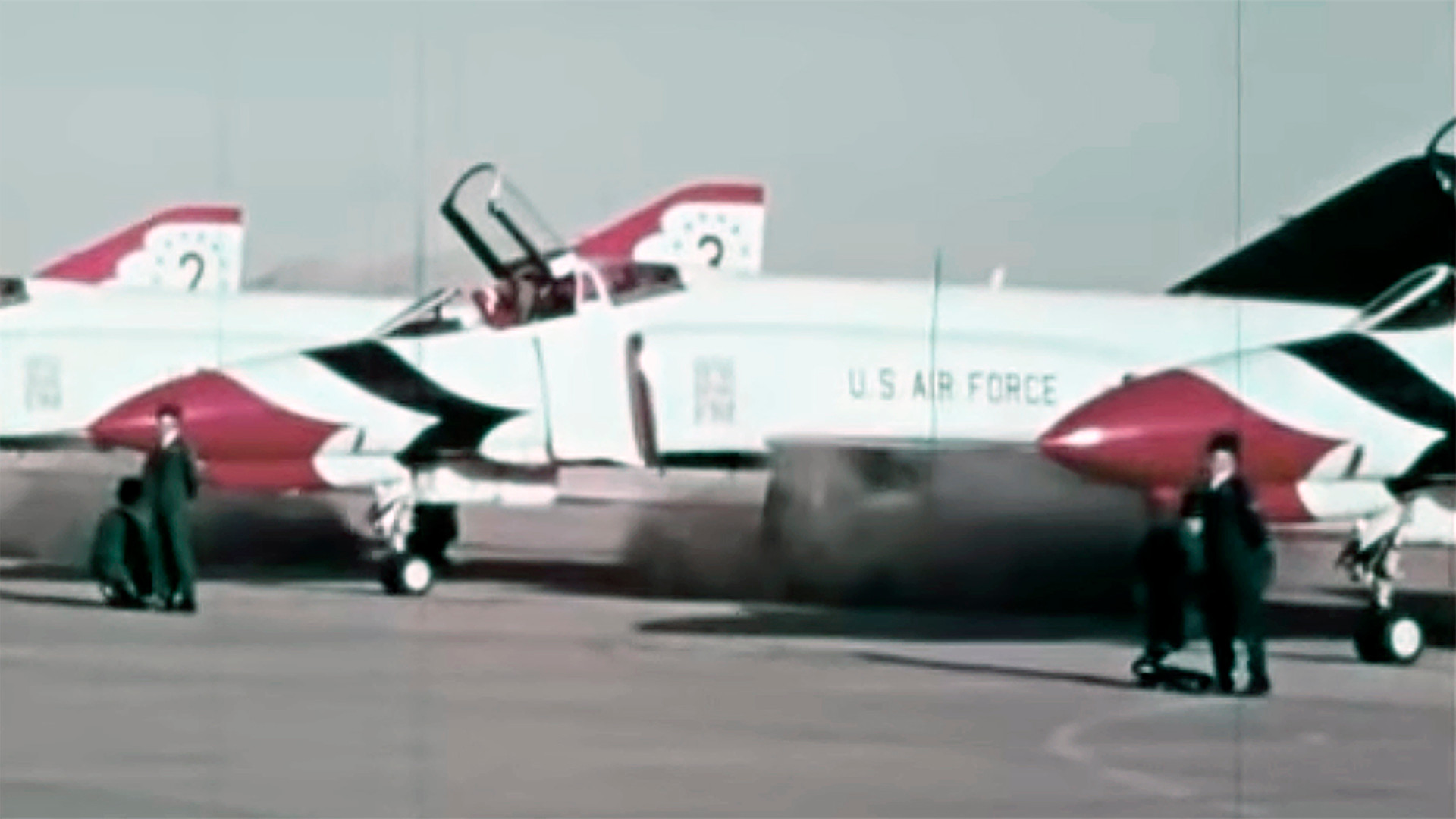The U.S. Air Force’s Air Demonstration Squadron, better known as the Thunderbirds, has flown a number of different jets over the years, all of which have carried variations on a distinctive and instantly recognizable red, white, and blue paint scheme. It’s a patriotic, high-visibility look that’s very well suited to their already attention-grabbing airshow routines. However, between the late 1950s and early 1970s, when the team flew the F-100C Super Sabre and then the F-4E Phantom II, one of the jets always had a very distinctive variation on this livery, with an all-black tail. There’s a very good reason for why the “slot” jet, the aircraft assigned to fly in the position right behind the lead plane, was colored this way and why the individual at the controls invariably became known as ‘Captain Carbon.’
The Thunderbirds’ black-tailed jet first emerged after the squadron began flying the F-100C in 1956. The team, which was formally established three years earlier, had previously flown the F-84G Thunderjet and then the F-84F Thunderstreak.

The Super Sabre, which had entered service in 1954, had given the Air Force its first fighter capable of flying at supersonic speed in level flight. The jet, and its afterburning Pratt & Whitney J57 turbojet, rated at 11,700 pounds of thrust, then brought that capability to the Thunderbirds. Sonic booms continued to be a part of the squadron’s routine, if whoever was hosting the airshow they were attending allowed it. This continued even after the team transitioned from the F-100 to the F-4, until the Federal Aviation Administration banned supersonic flight over the United States entirely in 1973.
The F-100Cs also apparently created a different problem for the Thunderbirds, as retired Air Force Colonel Steve Dwelle, who flew with the team between 1971 and 1972, after flying 198 combat missions in the F-100 during the Vietnam War, explained in an interview with the Blue Angel Phantoms YouTube channel, seen in full below, in 2018.

“Well it started, to my knowledge, in the F-100-era,” Dwelle said of the black tail. “The slot pilot, when he’s tucked into position, his tail is right up in the exhaust of the lead ship airplane.”
What this meant was that the slot aircraft was also right in the path of the lead ship’s exhaust plume, and all the sooty gasses inside it. It’s not hard to imagine how the slot jet might’ve looked after a routine. Many early tubrojet engines, including the J57, were notoriously “dirty.”
“Over the course of time, the crew chief had to keep wiping all this soot off the tail and wiping it off, and wiping it off, and wiping it off,” Dwelle continued. “Finally they decided that … they’d just leave it on there and see what happens.”

What happened is pretty obvious.
“So that’s what happened and it’s just carbon that’s coming out of the engine and sticking to the tail,” Dwelle said. “We affectionately refer to the slot pilot … as ‘Captain Carbon.'”
The use of the black tail continued when the Thunderbirds transitioned to the F-4E in 1969. These jets each had a pair of J79 turbojets rated at 17,900 pounds of thrust, at full afterburner, apiece.

The introduction of tubofan engines and smokeless combusters, the latter of which were also added to later versions of the J79, among others, eventually led to the disppearance of the black tail. The practice was gone by the time the Thunderbirds began flying the far more anemic T-38 Talon jet trainer in 1974. Each of those jets had a pair of J85 afterburning turbojets. These engines were also just substantially less powerful, but also more economical than any variant of the J79. With their afterburners going, they are rated at around 2,900 pounds of thrust.
The slot jet’s tail black did not return when the Thunderbirds began flying F-16 Vipers in 1983, either, which leveraged the far less smokey F100 turbofan. It’s not clear if that pilot in that position still gets the Captain Carbon nickname, either.
It’s also interesting to note that the Navy’s flight demonstration team, the Blue Angels, do not ever appear to have had to deal with a black tail on their slot jets, including their F-4s.
Today, the black-tailed Thunderbirds, a creation of crew chiefs fed up with having to constantly clean soot off the slot jet, are just another interesting piece of the team’s storied history.
Contact the author: joe@thedrive.com
